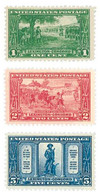
# 617-19 - Complete Set, 1925 Lexington-Concord Sesquicentennial
1925 Lexington-Concord Issue
First City: Washington, DC; Concord, MA; Concord Junction, MA; Boston, MA; Cambridge, MA; Lexington, MA
Perforation: 11
Washington Takes Command Of The Continental Army

On July 3, 1775, George Washington took command of the Continental Army at Cambridge, Massachusetts.
As America fought its war for independence against the British, it was decided that a commander in chief was needed to lead the newly established Continental Army. Several men were considered, including John Hancock.

Washington was among those in consideration and he arrived at the Second Continental Congress in full military uniform, signaling his intention to fight in the war. While some argued against Washington, the Continental Congress ultimately decided that his Virginian roots would help garner support from the southern colonies. Washington was officially appointed the commander of the Continental Army on June 16. In his acceptance speech, he said, "I am truly sensible of the high Honor done to me in this appointment I do not think myself equal to the Command I am honored with."

Although he was faced with the very real threat of death, either in battle or following a conviction for treason, Washington refused compensation for his service and asked only to have his expenses reimbursed. Within days of receiving his commission, Washington left for Massachusetts, where his army awaited.
On July 3, 1775, Washington officially took command of the 14,500-member Continental Army in Cambridge, Massachusetts, riding out ahead of them and drawing his sword. Many of the troops were suspicious of the outsider they'd never heard of. But Washington was determined to transform the ragtag band of undisciplined men into a well-structured army. At Cambridge, it was evident that Washington possessed the leadership qualities to guide America through her fight for Independence.
The Washington at Cambridge Stamp

The 1925 Washington at Cambridge stamp is part of the Lexington-Concord Issue, which was the first set of US postage stamps to honor the War of Independence. Although part of the Lexington-Concord issue, US #617 pictures General George Washington leading colonial forces at Cambridge Common on July 3, 1775. This was two-and-a-half months after the battles at Lexington and Concord. A driving factor for this scene's inclusion in the set was due to the famed Washington Elm. According to legend, Washington stood under the elm tree as he took command of the Continental Army.
Over the years, the tree was badly damaged and was accidentally knocked over during repair attempts in 1923. Revolutionary War scholars debate the historical accuracy of the scene pictured on this stamp. Some protest that the army would have been too busy and not properly trained to assemble in the way shown. Whether the story is true or not, a plaque stands where the tree once did, according to the Cambridge Historical Commission, not because Washington ever stood there, but as a monument to a belief.
1925 Lexington-Concord Issue
First City: Washington, DC; Concord, MA; Concord Junction, MA; Boston, MA; Cambridge, MA; Lexington, MA
Perforation: 11
Washington Takes Command Of The Continental Army

On July 3, 1775, George Washington took command of the Continental Army at Cambridge, Massachusetts.
As America fought its war for independence against the British, it was decided that a commander in chief was needed to lead the newly established Continental Army. Several men were considered, including John Hancock.

Washington was among those in consideration and he arrived at the Second Continental Congress in full military uniform, signaling his intention to fight in the war. While some argued against Washington, the Continental Congress ultimately decided that his Virginian roots would help garner support from the southern colonies. Washington was officially appointed the commander of the Continental Army on June 16. In his acceptance speech, he said, "I am truly sensible of the high Honor done to me in this appointment I do not think myself equal to the Command I am honored with."

Although he was faced with the very real threat of death, either in battle or following a conviction for treason, Washington refused compensation for his service and asked only to have his expenses reimbursed. Within days of receiving his commission, Washington left for Massachusetts, where his army awaited.
On July 3, 1775, Washington officially took command of the 14,500-member Continental Army in Cambridge, Massachusetts, riding out ahead of them and drawing his sword. Many of the troops were suspicious of the outsider they'd never heard of. But Washington was determined to transform the ragtag band of undisciplined men into a well-structured army. At Cambridge, it was evident that Washington possessed the leadership qualities to guide America through her fight for Independence.
The Washington at Cambridge Stamp

The 1925 Washington at Cambridge stamp is part of the Lexington-Concord Issue, which was the first set of US postage stamps to honor the War of Independence. Although part of the Lexington-Concord issue, US #617 pictures General George Washington leading colonial forces at Cambridge Common on July 3, 1775. This was two-and-a-half months after the battles at Lexington and Concord. A driving factor for this scene's inclusion in the set was due to the famed Washington Elm. According to legend, Washington stood under the elm tree as he took command of the Continental Army.
Over the years, the tree was badly damaged and was accidentally knocked over during repair attempts in 1923. Revolutionary War scholars debate the historical accuracy of the scene pictured on this stamp. Some protest that the army would have been too busy and not properly trained to assemble in the way shown. Whether the story is true or not, a plaque stands where the tree once did, according to the Cambridge Historical Commission, not because Washington ever stood there, but as a monument to a belief.








